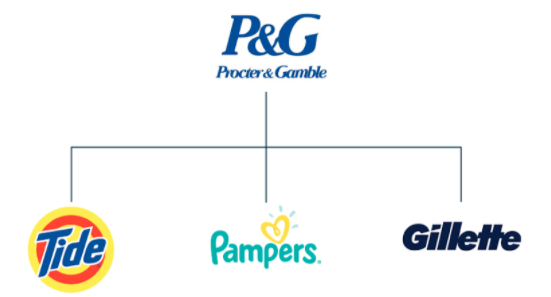What is Brand Architecture?
Brand Architecture, simply put, is a method of organizing brands, products, and services in a way that makes it easy for customers to see the links between each, find what they are looking for, and understand what your company can offer them.
Conversely, a muddled Brand Architecture confuses customers not only about what products and services your company offers but also about the value proposition for the entire brand family. As companies grow, it’s common for them to gradually become a multi-layered mix of new and legacy brands, each with its own identity. This can perplex customers, however, and make them less willing to buy.
So let’s take a look at the main types of brand architecture models, and how you can structure your brands to prevent confusion and drive sales.
There are four popular brand architecture models established by Aaker and Joachimsthaler’s framework called the Brand Relationship Spectrum and are named as follows: Branded House, Sub-Brands, Endorsed Brands, and House of Brands.
Branded House
A Branded House is largely the most well-known structure. This model has one parent brand serving as the “umbrella” for a wide product range. An example of this is Coca-Cola. After several years of having its drinks marketed individually, the announced last year a move to a “One Brand” strategy, meaning Diet Coke, Coca-Cola Zero Sugar, and Coca-Cola Life would all be advertised under the main Coca-Cola umbrella, thereby turning these three sub-brands into variants of the parent brand.
Sub-Brands
Sub-Brands also use the parent brand as the mainframe of reference but keep the individual brands more distinct by giving each its own visual and voice distinction. Take Virgin, for example. The Virgin parent brand houses several brands over an array of industries—Virgin Hotels, Virgin Active, Virgin Records, and so on. All are linked to the parent brand through the use of the Virgin logo and all serve the purpose of “changing business for good,” but each brand has its own distinct voice and trademarked sub-brand logo.
Endorsed Brands
Endorsed Brands are less linked to the parent than sub-brands, as they have unique names, but they still use elements from the parent as a quality guarantee. In contrast to Sub-Brands, Endorsed Brands are closer to the house of brands architecture. In this case, the endorsed brand has a separate identity and uses the parent brand’s endorsement as a quality stamp to help the child brand build awareness and trust.
House of Brands
In this model, all brands are independent, stand-alone brands. While a branded house tries to make its new products or services part of the parent brand, a House of Brands creates a clear separation between parent companies and their child brands, with the general consumer likely unaware of their connection.
Benefits of a Consistent Brand Architecture
Choosing which one of these models is right for your company involves considering many factors such as your parent brand’s current brand awareness, your existing architecture, your marketing goals, your current product/services mix, and new products in your pipeline.
Moving to a new type of brand architecture is a big undertaking, as it can involve everything from a new messaging strategy to redirecting legacy websites. However, the benefits of building a solid, consistent architecture are considerable—providing clarity to your customers, grabbing attention with a bold story, growing revenue through cross-selling, and creating a more inclusive culture.
The Case for Partnering with a Neutral Party
As you begin to tackle this project, know that it’s not always easy to decide which model to use because you’ve grown accustomed to how things are inside your company and may not have a clear view of how your brands are perceived by outsiders. The implications of this work go beyond the structure of your products but also the name of your company as well as the sub-brands or products you offer. Our team has been named a Top Naming Agency by DesignRush for exactly this kind of work and we would love to use this knowledge to support your branding and naming goals.
In many cases, a branding agency can bring great value to a brand consolidation project. By serving as an impartial observer who asks probing questions and makes strategic recommendations, they can figure out which brand architecture model best fits your needs, and help guide you down the right path based on brand architecture examples that have seen success in your industry.
Clover Collective has performed numerous branding projects over the years across diverse industries. Check out our branding services if you’re interested in partnering with our experienced brand architects.






